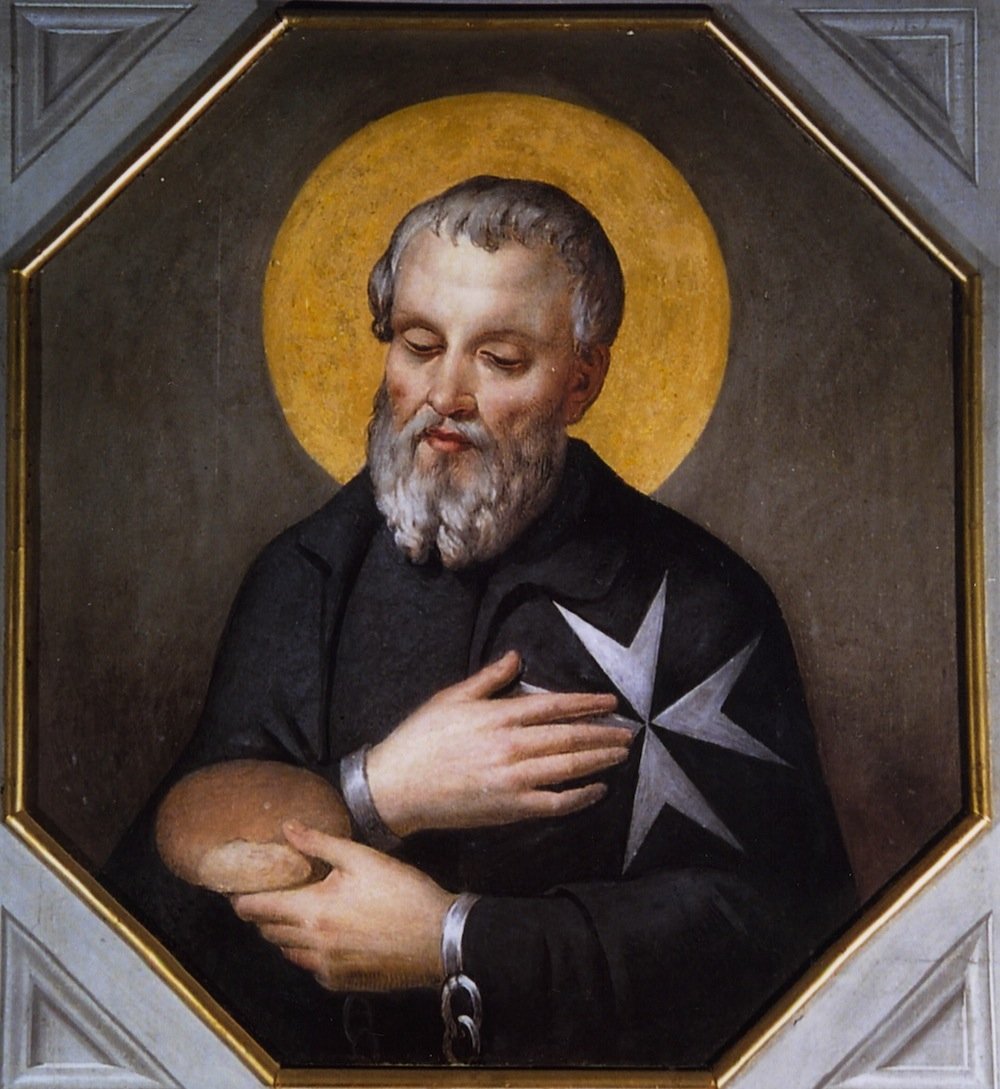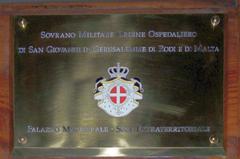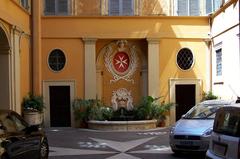
Magistral Palace Rome: Visiting Hours, Tickets, and Comprehensive Guide
Date: 14/06/2025
Introduction: The Magistral Palace and Its Significance
Situated at Via dei Condotti 68 in the heart of Rome, the Magistral Palace (Palazzo Magistrale) stands as a unique landmark imbued with centuries of history, diplomacy, and humanitarian activity. As the headquarters of the Sovereign Military Order of Malta (SMOM), the palace represents a rare blend of architectural restraint and sovereign prestige. Since its acquisition by Antonio Bosio in the early 17th century and its bequest to the Order in 1629, the palace has played a pivotal role in shaping religious, diplomatic, and cultural narratives. Today, its extraterritorial status further underscores its sovereign nature within Rome’s historic landscape. While public access to the interior is limited, the palace’s distinguished façade and enduring diplomatic presence offer an evocative experience for visitors. This guide delivers all you need to know about the Magistral Palace’s history, architecture, visitor logistics—including visiting hours, ticketing, accessibility—and recommendations for making your visit meaningful (Order of Malta Official Website, Intl Travel News).
Table of Contents
- Introduction
- History of the Magistral Palace
- Architecture and Symbolism
- Diplomatic and Sovereign Status
- Cultural and Institutional Highlights
- Visitor Information
- Travel Tips and Nearby Attractions
- The Magistral Palace in the Context of Rome
- FAQ
- Conclusion and Visit Summary
History of the Magistral Palace
The Magistral Palace’s origins date to the 16th century, when Antonio Bosio, a trailblazer in Christian archaeology, purchased the property. Following Bosio’s death in 1629, the estate was bequeathed to the Order of Malta, a storied institution with roots in the 11th century. After being displaced from Malta in 1798, the Order established its permanent headquarters here in 1834. The palace was granted extraterritorial status by the Italian government in 1869, a unique sovereignty that continues to distinguish it today (Order of Malta Official Website).
Architecturally, the palace began as two distinct buildings—the Palazzo del Monte and the original Auberge of Italy—unified and expanded from 1571 onwards. This evolution is still visible, offering a glimpse into the seat of power that has survived virtually unchanged for centuries (Archaeological Society of Malta, 2024).
Architecture and Symbolism
The three-story façade, with its ashlar veneer crowned by a corbelled cornice, is marked by humility in keeping with the Order’s values. The palace’s balcony displays the Order’s flags—symbols of its sovereignty and ongoing humanitarian mission. Inside, highlights include the chapel dedicated to St. John the Baptist and the Magistral Library and Archives, both central to the Order’s spiritual and cultural life.
Diplomatic and Sovereign Status
Since 1834, the Magistral Palace has functioned as the principal seat of government for the Sovereign Order of Malta, enjoying diplomatic status recognized by the Italian Republic. Its extraterritorial standing means the palace is essentially sovereign territory, akin to an embassy. The state and hospitaller flags, and the Grand Master’s flag when in residence, signal its ongoing role in international diplomacy and coordination of global humanitarian missions across 120+ countries (Order of Malta Official Website, Order of Malta Australia, 2021).
Cultural and Institutional Highlights
The Magistral Library and Archives
This renowned library holds one of the world’s most comprehensive collections on the Order of Malta, featuring rare manuscripts and official documents—an invaluable resource for scholars and historians (Order of Malta Official Website).
The Magistral Chapel
Dedicated to St. John the Baptist, the chapel is an active place of worship, hosting daily Mass and solemn ceremonies that preserve the Order’s spiritual traditions (Order of Malta Australia, 2021).
The Magistral Mint and Post Office
Since 1966, the Magistral Mint and Post Office have issued unique coins and stamps, with the Order’s mail recognized in 57 countries. These services help fund charitable activities (Poste Magistrali History).
Visitor Information
Visiting Hours
- General Access: The palace interior is not open for public visits or casual tours. All access is strictly by invitation or pre-arranged guided tours.
- Exterior Viewing: The façade, flags, and entrance are visible 24/7 from Via dei Condotti.
Tickets and Admission
- Interior Access: Entry is only possible through special guided tours, which are rarely available and typically reserved for dignitaries or official events.
- Exterior: No ticket or reservation is needed to view the building from the street.
Accessibility
- Mobility: Via dei Condotti is flat and paved, making the palace’s exterior accessible to visitors with mobility challenges.
- Interior Access: Should you be invited inside for an official event or tour, the palace is equipped with ramps and elevators.
Guided Tours and Special Events
- Regular Tours: Not available for the Magistral Palace itself due to its diplomatic and residential status.
- Magistral Villa Tours: For a more interactive SMOM experience, public tours are available at the Magistral Villa on Aventine Hill, featuring the famous “Keyhole of Malta.” Tours run Fridays and select Saturdays from September to June, with advance booking required (Intl Travel News).
Travel Tips and Nearby Attractions
- Best Time to Visit: Early morning or late afternoon for fewer crowds and better lighting.
- Transport: The Spagna metro station (Line A) is a five-minute walk; numerous bus routes serve the area.
- Nearby Attractions: Spanish Steps, Piazza di Spagna, Trevi Fountain, Villa Borghese, and the historic Caffè Greco (Italy Tourist Information).
The Magistral Palace in the Context of Rome
The palace is exceptional among Rome’s landmarks due to its ongoing role as a sovereign diplomatic seat and humanitarian hub. Alongside the Magistral Villa, it underscores Rome’s place as a center of international diplomacy and culture (Order of Malta Estonia).
Frequently Asked Questions (FAQ)
Is the Magistral Palace open to the public?
No, interior access is not open to the public except for official events by invitation. The exterior can be viewed at any time.
Are tickets required?
No tickets are needed to view the exterior. Interior visits are by invitation only.
How do I visit the Magistral Villa and Keyhole?
Contact [email protected] to arrange a tour. Fees apply.
Is the area accessible for people with disabilities?
Yes, Via dei Condotti is flat and paved, but expect crowds and some cobblestones nearby.
Can I take photographs?
Yes, photography of the exterior is permitted and encouraged.
Recommendations for a Memorable Visit
- Combine your visit with nearby attractions like the Spanish Steps and Trevi Fountain.
- For a deeper experience, book a tour of the Magistral Villa on Aventine Hill.
- Be respectful—this is a functioning diplomatic residence.
- Use public transport to avoid parking hassles in the city center.
Conclusion and Visit Summary
The Magistral Palace stands as a testament to Rome’s layered history, unique in its sovereign status and ongoing humanitarian mission. While the palace’s interior remains off-limits to the general public, the dignified exterior and prime location make it a worthwhile stop for those exploring Rome’s historical and diplomatic neighborhoods. For a more immersive experience, pair your visit with a guided tour of the Magistral Villa, home to the iconic Keyhole of Malta.
To maximize your visit, plan ahead, respect the site’s diplomatic function, and take advantage of official resources and guided tour opportunities where available. Download the Audiala app for interactive guides and the latest updates—and follow us for ongoing insights into Rome’s most fascinating sites.
Official Sources and References
- Order of Malta Official Website
- Intl Travel News
- Order of Malta Australia, Chaplains Handbook 2021
- Archaeological Society of Malta – Magistral Palace Investigations
- Order of Malta Estonia – History
- Poste Magistrali History
- Italy Tourist Information
Related Article: Palazzo Barberini – Visiting Hours, Tickets & Visitor Guide
Introduction
Palazzo Barberini is a Baroque masterpiece and home to the National Gallery of Ancient Art, featuring works by Caravaggio, Raphael, and Bernini. This section summarizes essential visitor information.
Visiting Hours
- Tuesday to Sunday: 10:00 a.m. – 7:00 p.m. (last admission 6:00 p.m.)
- Closed Mondays, December 25th, January 1st (Barberini Corsini Official Site)
Ticketing
- Full ticket: €15 (includes Galleria Corsini; valid 20 days)
- Reduced: €2 (EU citizens 18–25)
- Free: First Sunday of each month
- Special exhibition tickets sold separately (Rome Info, Palazzo Barberini Caravaggio Exhibition)
Accessibility & Facilities
- Wheelchair accessible: Ramps, elevators, and barrier-free routes (Barberini Corsini Accessibility)
- Restrooms, café, gift shop, cloakroom
Getting There
- Address: Via delle Quattro Fontane, 13, 00184 Rome
- Metro: Barberini (Line A)
- Bus: Multiple lines
Tips
- Book tickets in advance online.
- Combine your visit with nearby sites: Trevi Fountain, Spanish Steps, Quirinale Palace.
- Photography permitted (no flash/tripods).
Further Resources
- Barberini Corsini Official Site
- Palazzo Barberini Caravaggio Exhibition
- Full Suitcase Rome Tips
- Rome Info
For more travel inspiration, guides, and insider tips on Rome’s renowned historical sites, download the Audiala app and follow us on social media!



















































































































































































































































